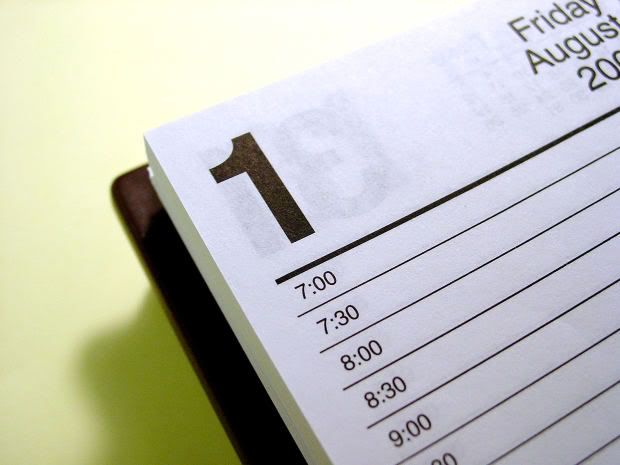 The topic this month is Time Management? How appropriate that I would remember it’s my day to blog twenty-five minutes before midnight. This is what I do. It’s how I roll. I serve an eleventh-hour God, and I am made in His image. Although, I doubt He waits until the last minute due to procrastination or forgetfulness.
The topic this month is Time Management? How appropriate that I would remember it’s my day to blog twenty-five minutes before midnight. This is what I do. It’s how I roll. I serve an eleventh-hour God, and I am made in His image. Although, I doubt He waits until the last minute due to procrastination or forgetfulness.Okay, enough of the excuses. Ironically, I’ve given talks on this very subject. I’ll give you a mini-lesson here on how to set up a goal sheet so you can finish your project on time.
You can use either the spreadsheet program on your computer or you can use paper. I caution, however, that if you use the antiquated spiral notebook, use a pencil, because you will inevitably be erasing. I like the computer because I can add or delete rows or change tasks as needed.
I’ll tell you how I set up my goals sheet, but feel free to change it for your own needs. Just keep it simple, or it will be more trouble than it’s worth.
All you need is two columns:
| Week | Done X |
And now, my disclaimer. This is my ideal goal sheet. Not every novel (or non-fiction work for that matter) is created equal. Each one is unique and needs more or less work in certain areas than other novels do. Goals get changed, rearranged, omitted, added. It becomes a living, breathing partner in the writing process. But I’m here to tell ya, my goal sheet comes in mighty handy when I’m faced with a four-month contract.
As you read my sheet, let me explain some of the tools I use. You may have other plotting tools. Or none. Whatever works for you.
- Skeleton – This is Randy Ingermanson’s brainchild.
- GMC – From a book by Debra Dixon. If you don’t have this book, and you’ve never learned about Goal, Motivation, and Conflict, order it today!
- SOP – Seat of the Pants. It helps me to write the first few chapters without plotting first to get a feel of the characters. I may not use these chapters in the final draft, but they’re important to get me into the rhythm of the story.
- ALL IN ONE – My term for a spreadsheet notebook I’ve created. It has several sheets to help me keep track and plot my story. I’ve discussed much of it on my blog. Click on any of the four lessons titled, “Organize Yourself as a Writer.” You will note that the goal setting sheet is different from the one I’m showing you today. I started out using that one, but as I said. This sheet lives and breathes. It’s evolved for me, but if you prefer the one on the blog, that’s fine too.
- Highlight – This is from a class I took with Margie Lawson who presented the EDITS System. You can buy her lecture packet that includes this and other wonderful tools on her website.
- Put aside – A story, like fine wine, needs to breathe. Around Week 12, I try to not look at it for as long as I can get away with and still meet my deadline. When I come back to it, I put on my critiquing glasses (not real ones, so don’t ask me where I bought them <grin>) and read objectively. The longer I let the story sit, the easier it is to pretend I’m just another reader.
That is . . . if you can find the time.
***************
Kathleen E. Kovach is an award winning author, leader of the local critique group
 JOY Writers, and the Rocky Mountain Zone Director for American Christian Fiction Writers. A mom and grandmother, she lives in northeast Colorado with her husband of over three decades. Visit her online: www.craftcinema.blogspot.com, www.kathleenekovach.blogspot.com, www.KathleenEKovach.com.
JOY Writers, and the Rocky Mountain Zone Director for American Christian Fiction Writers. A mom and grandmother, she lives in northeast Colorado with her husband of over three decades. Visit her online: www.craftcinema.blogspot.com, www.kathleenekovach.blogspot.com, www.KathleenEKovach.com.











4 comments:
Thinking of you as taking the "the fun" out of anything is incongruent!
Very helpful, Kathleen!
Angela Breidenbach
I had to look up incongruent. LOL
Thanks Angie! I hope it works for you.
Post a Comment